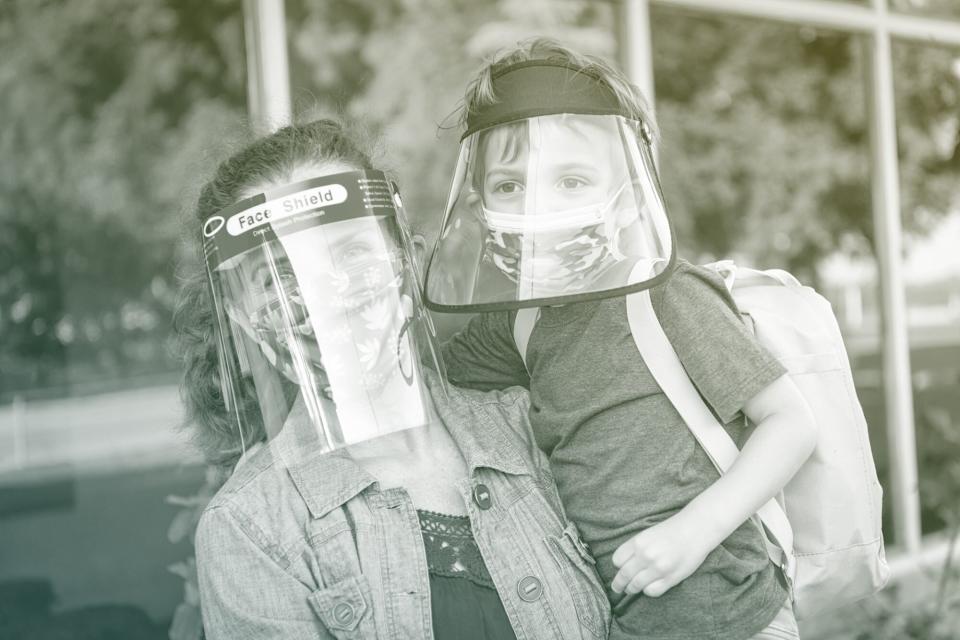Face Shields vs. Face Masks: What's the Best COVID-19 Protection for Kids?

With COVID-19 restrictions lifting all over the country, the Centers for Disease Control and Prevention (CDC) have adjusted their guidance on face masks, providing the flexibility to keep up with the times. It's easy to find out what you should be wearing where you live: You simply check their website to see if your community is at low, medium, or high risk, and mask up according to their recommendations. The CDC also urges everyone over the age of 5 to be vaccinated, which further lowers risk, mask or no.
At the beginning of the pandemic, there was a lot of confusion about what face covering would be most appropriate. Since that time, the CDC has settled on the following for children: If they are age 2 and older and unvaccinated, they should continue to wear face masks inside; beyond that, check the community level and school standards. Disposable surgical masks are the most effective, after which layered, tightly woven cloth masks are best; masks that are sheer or have a loose weave are not ideal.
The problem is that many kids dislike face masks, finding them hot and uncomfortable especially when they are fitted to the face (as the CDC recommends, with a wire shaped around the bridge of the nose). Preventing gaps around the edges of the masks is essential, so some parents stack a disposable and cloth mask together, or use a brace that frames the mask against the face—but some children balk at this. Still other kids' masks require constant knotting to make them tighter, and continue to fall off.
Frustrated, many parents have turned over the past few years to face shields instead. These plastic barriers cover the entire face (including the eyes), and come in appealingly cute styles for kids. Unfortunately, the CDC does not recommend using them in place of masks. In a press release issued near the height of the pandemic, its experts wrote, "At this time, it is not known what level of protection a face shield provides to people nearby from the spray of respiratory droplets from the wearer. There is currently not enough evidence to support the effectiveness of face shields for source control."
Newer studies have suggested that face shields offer impressive protection against tinier viral particles when compared to a mask. But for a truly solid system, kids should combine them with masks that guard against getting or transmitting COVID-19. Here's what you need to know about their options.

Juanmonino/Getty Images
The Pros of Face Shields
For kids, there are several advantages to wearing the curved plastic barriers.
Shields don't directly touch the face, and they stay put with built-in headbands. This design might feel more comfortable to little ones—especially in warm, humid weather.
Unlike face masks, shields guard the wearer's eyes. This is important because mucous membranes in the eye can be a portal for transmission of the coronavirus.
Shields' transparent exteriors make communication easier for the deaf population, kids with special needs and those with learning disorders. (Note: The CDC recommends clear masks.)
Shields don't need adjusting as often as masks. Less contact with the face means reduced odds of contracting the coronavirus.
Shields can be washed and re-worn within minutes, unlike masks.
The Cons of Face Shields
The coronavirus is usually spread when someone who has it speaks, exhales, coughs or sneezes, emitting viral particles and droplets that get inhaled by someone nearby. These may also land on another person's eyes, nose, or mouth, or get picked up and spread by their hands to their own mucous membranes. Wearing a face mask keeps these contagions contained more effectively than wearing a shield does, and that restricts the spread of the virus. Properly worn, masks should cover the mouth and nose, fit securely underneath the chin, and rest snugly against the sides of the face, says Marnie Granados, M.D., a pediatrician with Children's Health of Orange County, in Orange County, California.
On the whole, face shields do not defend as well against the transmission of the virus that causes COVID-19. Often their plastic barriers do not fit neatly against the face, meaning that infectious particles can still flow around the bottom and sides of the shield, causing issues in both directions. Their lack of protection became abundantly clear early in the pandemic when employees at a Swiss hotel found themselves in the middle of a coronavirus outbreak; only the ones wearing face shields ended up testing positive for the coronavirus. They were more contagious, too: In fact, a guest who was previously free of COVID-19 contracted it after contact with a shield-wearing employee.
How to Wear Face Shields Properly
What to do if your kids love their face shields? You don't have to throw them out—just don't let them be the only defense you employ. Use them instead to provide added protection against COVID-19, and encourage little ones to wear face masks underneath them. This combination covers their mouth, nose, and eyes, which will greatly decrease their odds of contracting the virus. And if your kid has COVID-19 (many children are asymptomatic), wearing both items will better protect those around them from getting sick. (Note: Kids under age 2 should never wear face masks, which can be a suffocation risk.)
For maximum protection, make sure your child wears a shield that fully covers the sides of their face and stretches down past the chin. Hooded versions provide more coverage. Always have kids wash their hands or use hand sanitizer before handling a shield, and if it is reusable, clean and disinfect it after use. (Disposable shields can be tossed after every use, which may be easier for parents—plus, no worries about disinfectant residue!) After the shield is cleaned, users should wash their hands again.

